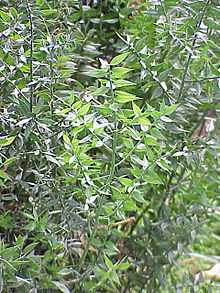Ruscus aculeatus
| Butcher's broom | |
|---|---|
 | |
| Scientific classification | |
| Kingdom: | Plantae |
| Clade: | Angiosperms |
| Clade: | Monocots |
| Order: | Asparagales |
| Family: | Asparagaceae |
| Subfamily: | Nolinoideae |
| Genus: | Ruscus |
| Species: | R. aculeatus |
| Binomial name | |
| Ruscus aculeatus L. | |
Ruscus aculeatus is a low evergreen Eurasian shrub, with flat shoots known as cladodes that give the appearance of stiff, spine-tipped leaves. Small greenish flowers appear in spring, and are borne singly in the centre of the cladodes. The female flowers are followed by a red berry, and the seeds are bird-distributed, but the plant also spreads vegetatively by means of rhizomes. Ruscus aculeatus occurs in woodlands and hedgerows, where it is tolerant of deep shade, and also on coastal cliffs. It is also widely planted in gardens, and has spread as a garden escape in many areas outside its native range.


Common names
- Butcher's Broom
- Kneeholy, Knee Holly, Kneeholm
- Jew's Myrtle
- Sweet Broom
- Pettigree
- Λαγομηλιά (Lagomilia): Hare's apple (in greek)
Medicinal Uses
Butcher's broom has been known to enhance blood flow to the brain, legs, and hands. It has been used to relieve constipation and water retention and improve circulation. Since Butcher's broom tightens blood vessels and capillaries, it is used to treat varicose veins.[1]
It is also used for hemorrhoids.[2] In a 1999 open-label (not blinded) clinical trial, the herb was tested as a hemorrhoid treatment and showed statistically significant positive results.[3] It also showed reduction in venous insufficiency in two other studies. It was approved by the German Commission E guidelines for hemorrhoids treatment[3] It is occasionally prescribed for varicose veins which can be a complication of pregnancy. However, since it is classified as a natural product, there is no evidence or trials to suggest complete safety for the fetus. A qualified healthcare practitioner should be consulted prior to using this compound during pregnancy.
A study published in 1999 suggested that Butcher's Broom may also improve symptoms of postural hypotension without increasing supine blood pressure.[4] Suggested mechanisms to explain this include stimulation of venous alpha 1 and 2 adrenoreceptors and decreased capillary permeability.
References
| Wikimedia Commons has media related to Ruscus aculeatus. |
| Wikispecies has information related to: Ruscus aculeatus |
- ↑ Bouskela, Eliete; Cyrino, Fatima Z. G. A.; Marcelon, Gilbert (1993). "Effects of Ruscus Extract on the Internal Diameter of Arterioles and Venules of the Hamster Cheek Pouch Microcirculation". Journal of Cardiovascular Pharmacology 22 (2): 221–4. doi:10.1097/00005344-199308000-00008. PMID 7692161.
- ↑ MacKay, Douglas (2001). "Hemorrhoids and Varicose Veins: A Review of Treatment Options". Alternative Medicine Review 6 (2): 126–40. PMID 11302778.
- ↑ 3.0 3.1 Abascal, Kathy; Yarnell, Eric (2005). "Botanical Treatments for Hemorrhoids". Alternative and Complementary Therapies 11 (6): 285–9. doi:10.1089/act.2005.11.285.
- ↑ Redman, Deborah A. (2000). "Ruscus aculeatus (Butcher's Broom) as a Potential Treatment for Orthostatic Hypotension, with a Case Report". The Journal of Alternative and Complementary Medicine 6 (6): 539–49. doi:10.1089/acm.2000.6.539. PMID 11152059.
External links
- botanical.com: Broom, Butcher's
- nutrasanus.com: Butcher's Broom Benefits and Information